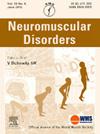142P A preliminary machine learning retrospective observational study to predict treatment response to nusinersen in non-sitter spinal muscular atrophy
IF 2.7
4区 医学
Q2 CLINICAL NEUROLOGY
引用次数: 0
Abstract
Disease-modifying treatments, such as nusinersen, have significantly improved the disease trajectory of Spinal Muscular Atrophy (SMA) patients. Treatment response is heterogeneous, and predicting response is crucial for clinicians to give realistic guidance to patients and carers when counselling about treatment options. We collected data on 124 patients from the SMA Reach UK and Italian Network studies. Participants were included if they were treated under 4 years and were non-sitters at nusinersen initiation, were randomly allocated to training (80%) and testing cohorts (20%). Tree and regression-based machine learning for survival outcomes were compared, and oblique random forests were selected, with a testing C-Index of 0.74. The features were selected from items of the CHOP and HINE-2, respiratory symptoms and bulbar interventions using mutual information. In total, 62 (50%) have achieved sitting, at a median age of 2.4 years. The predicted median time-to-sitting in those requiring NG or G-Tubes at treatment was 4-months later on average than those without, and this was the most influential factor. The ability to kick at treatment, (≥1 on the HINE-2 item) was also influential in predicting the likelihood of sitting, as was antigravity shoulder movement in supine and ability to reach in side-lying (4 on items 1 and 8), and neck muscle activation in pull to sit (≥2 on item 14) and rolling fully prone from supine when elicited from arms (≥3 on item 7) on the CHOP at treatment. Most notably, those who could roll fully prone from supine had a median predicted time-to-sit 5.8 months earlier than an identical patient who could not. Nusinersen starting and symptom onset age were less influential, whilst SMN2 copy numbers did not improve the model. This work provides a tool to predict treatment response in nusinersen-treated patients and has the potential to be extended to other treatment options, moving clinicians towards personalised treatment plans for each patient.
142P 预测非坐骨型脊髓性肌萎缩症患者对诺西能森治疗反应的初步机器学习回顾性观察研究
疾病改变疗法(如纽西奈森)大大改善了脊髓性肌肉萎缩症(SMA)患者的疾病轨迹。治疗反应各不相同,因此预测治疗反应对于临床医生在为患者和护理人员提供治疗方案咨询时提供切合实际的指导至关重要。我们从 SMA Reach UK 和意大利网络研究中收集了 124 名患者的数据。如果参与者接受治疗的时间不足 4 年,并且在开始使用奴西奈森时没有坐位,我们就将其纳入研究,并将其随机分配到训练组(80%)和测试组(20%)。对基于树和回归的生存结果机器学习进行了比较,并选择了斜向随机森林,测试 C 指数为 0.74。使用互信息从 CHOP 和 HINE-2 的项目、呼吸道症状和球部干预中选择特征。共有 62 人(50%)实现了坐位,中位年龄为 2.4 岁。在治疗时需要插 NG 或 G 型管的患者,其坐起时间的预测中位数平均比不需要插 NG 或 G 型管的患者晚 4 个月,这是影响最大的因素。治疗时的踢腿能力(在 HINE-2 项目中≥1)对预测坐起的可能性也有影响,同样有影响的还有仰卧时的反重力肩部运动和侧卧时的伸手能力(在项目 1 和 8 中为 4),以及治疗时的颈部肌肉激活(在项目 14 中为≥2)和从仰卧位完全俯卧翻滚(在项目 7 中为≥3)。最值得注意的是,与不能完全仰卧翻身的相同患者相比,能完全仰卧翻身的患者的中位预测坐位时间提前了 5.8 个月。奴西那生起始年龄和症状发作年龄的影响较小,而SMN2拷贝数并没有改善模型。这项研究提供了一种工具来预测接受奴西尼森治疗的患者的治疗反应,并有可能扩展到其他治疗方案,使临床医生为每位患者制定个性化的治疗计划。
本文章由计算机程序翻译,如有差异,请以英文原文为准。
求助全文
约1分钟内获得全文
求助全文
来源期刊

Neuromuscular Disorders
医学-临床神经学
CiteScore
4.60
自引率
3.60%
发文量
543
审稿时长
53 days
期刊介绍:
This international, multidisciplinary journal covers all aspects of neuromuscular disorders in childhood and adult life (including the muscular dystrophies, spinal muscular atrophies, hereditary neuropathies, congenital myopathies, myasthenias, myotonic syndromes, metabolic myopathies and inflammatory myopathies).
The Editors welcome original articles from all areas of the field:
• Clinical aspects, such as new clinical entities, case studies of interest, treatment, management and rehabilitation (including biomechanics, orthotic design and surgery).
• Basic scientific studies of relevance to the clinical syndromes, including advances in the fields of molecular biology and genetics.
• Studies of animal models relevant to the human diseases.
The journal is aimed at a wide range of clinicians, pathologists, associated paramedical professionals and clinical and basic scientists with an interest in the study of neuromuscular disorders.
 求助内容:
求助内容: 应助结果提醒方式:
应助结果提醒方式:


